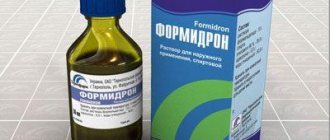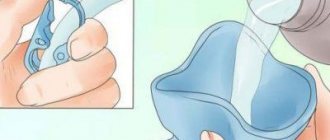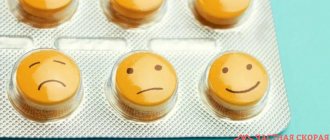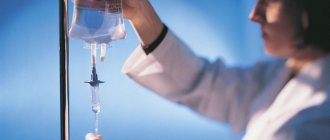Share with friends
Stopping medications should only be done under the guidance of your doctor. This is usually done gradually, reducing the dosage every few days. But in the case of phase inversion, when you switch from depression to hypomania or mania, withdrawal may occur more quickly.
If you're considering switching antidepressants or stopping taking them altogether, it's worth knowing how your body might respond to chemical changes in your body, and even more important to know how you can ease withdrawal symptoms.
Best possible situation: you don't even need to read this article because there is no syndrome (yay!).
Another possibility is that you are experiencing withdrawal reactions, but you are prepared for them and know that they are temporary.
Content:
- Use of antidepressants.
- Impact on a person.
- Side effects.
- Withdrawal syndrome.
- Treatment.
Many people believe that antidepressants cause addiction, mistaking it for the withdrawal syndrome that can occur if therapy is abruptly stopped. If you take the medicine correctly and under the supervision of a doctor, then there will be no negative manifestations.
What to expect after stopping antidepressants
Many symptoms are associated with depression or anxiety, so it's worth keeping an eye on how you feel and how long it lasts. Withdrawal syndrome often manifests itself as:
- Panic attacks
- Poor motor coordination
- Strong emotionality
- Dizziness or inability to concentrate
- Insomnia and/or nightmares
- Fever
- Strange twitching and “bumps”
- Loss of appetite
- Nausea
This doesn't sound very nice. Withdrawal syndrome is not a pleasant thing. But if you're experiencing any of the above, remember: it won't last forever. Everything will be alright. We have a list of tips to help you feel better during this difficult time.
Use of antidepressants
Antidepressants are psychotropics for the treatment of depression, acting on neurotransmitters, reducing anxiety and apathy, and increasing mental activity. At first they were used only for depression, but then properties were discovered that influenced other somatic, mental and neurological diseases. Some have an analgesic effect and are used for chronic pain and migraines. They are also used for therapy:
- post-traumatic stress disorder;
- narcolepsy;
- phobias;
- bulimia nervosa;
- neuroses;
- enuresis;
- panic states;
- nicotine craving;
- obsessive-compulsive disorder.
Until the 20th century, it was believed that the cause of depression was a decrease in the level of the neurotransmitter serotonin, and if you stimulate its production, you can get rid of the painful condition. Many corrected this situation by taking opiates and cocaine, natural antidepressants, until they encountered the problem of addiction. Then it turned out that hormonal disorders, various somatic diseases, alcoholism and drug addiction, and seasonal depressive conditions can also lead to depression.
Do not stop taking antidepressants unless directed by a psychiatrist
It's easy to make a decision like, “I don't want to burden the doctor,” and start changing or stopping medications on your own. But please do not change anything without your doctor's instructions, even if it is a small reduction in the dosage of your medication. Antidepressants are useful but are potent substances, so it is important to consult a professional about any minor changes.
When you visit your psychiatrist, ask how best to change your treatment. Your doctor can usually make a plan to reduce your dosage instead of stopping suddenly. If you start a new medicine, it will likely be introduced gradually while reducing the level of your current medicine. This will help alleviate withdrawal symptoms.
Prepare for panic attacks
You may feel panicked while coming off antidepressants, either occasionally or constantly. If you have already experienced panic attacks, use the techniques that already suit you. If you haven't encountered them, place a paper bag next to your bed so you can breathe into it during attacks. Practice deep breathing and counting objects in the room until your heartbeat calms down.
Have a cry
Tears go hand in hand with panic attacks. In some cases you may be very tearful. Our advice is to cry if you want to. It's nothing to be ashamed of, and honestly, tears can make you feel quite refreshed. Do not be afraid.
Impact on humans
When understanding the question of which antidepressants cause addiction, you should find out their effect on the body. The main effect is to increase the concentration of serotonin, dopamine, norepinephrine and other mediators to enhance their effect. This leads to the following improvements:
- mood improves;
- apathy passes;
- anxiety level decreases;
- emotional stress is relieved;
- mental activity increases;
- sleep and appetite are normalized.
Now there are many effective drugs that do not cause dependence on antidepressants. Based on the nature of their action, they are divided into three groups:
- stimulating (for lethargy and apathy);
- sedatives (for anxiety and agitation);
- stabilizing (for all manifestations).
They are prescribed based on which symptom is dominant in a person. It is not recommended to use medications from different groups at the same time due to the large number of side effects. The choice of drugs is individual, and it is not immediately possible to choose the appropriate option. All prescriptions must be made by a doctor, taking into account concomitant diseases, contraindications, and compatibility with other medications.
Peculiarities:
- You may gain weight while taking some medications for depression.
- It is difficult to immediately select the right option.
- The therapeutic effect does not appear immediately, at least after 2–3 weeks.
Incompatibility:
- You cannot combine antidepressants from different groups, as fatal serotonin syndrome may develop.
- When taken simultaneously with small amounts of alcohol, headaches and nausea may occur.
How to properly stop the drug
It is advisable to stop taking all antidepressants gradually. A stepwise reduction in dosage allows time for the brain neurons to adapt to the new concentration of substances. With the correct dosage reduction, drug withdrawal goes smoothly and without consequences.
A drug withdrawal regimen must be prescribed by the attending physician. It can have two development paths. The first is a complete refusal of antidepressants, the second is replacing the drug with another. In the first case, the dosage of amitriptyline is reduced by approximately 25 mg per month. If the patient does not tolerate such a reduction, by 10 mg once every two weeks. On average, complete cessation of use can be achieved after about 6 months.
In the second case, the dosage of the drug is reduced more quickly, but under the guise of another antidepressant. Thus, the dosage of one substance is gradually reduced, and the second is increased.
Sometimes patients complain of anxiety, panic attacks and other symptoms of the disease when the drug is discontinued. As a rule, this is not associated with withdrawal symptoms and is psychogenic in nature. The patient is afraid of being in the same state that led him to take amitriptyline, so he begins to notice familiar symptoms. Such people need a course of psychotherapy in order to teach them how to live without drug support.
Side effects
Different classes of drugs have their own side effects, but there are some common to all groups:
insomnia;- excitation;
- hallucinations;
- manic syndrome;
- lethargy, lethargy;
- drowsiness;
- sexual dysfunction;
- likelihood of suicide.
They can appear both with an overdose and with therapeutic doses. When you stop using it, the condition normalizes and you need to select another drug.
Withdrawal syndrome
Many people do not trust such medications because they do not know whether antidepressants are addictive and are afraid that they will have to be on pills for the rest of their lives. This occurs due to misunderstanding of their actions and failure to comply with doctor's instructions when canceling them. You should know that you cannot stop taking it on your own after feeling a little relief, this will lead to the return of depression. The medicine must be taken as a full course, from 4 to 9 months, sometimes longer.
If you abruptly stop taking the drug, the following symptoms appear:
anxiety;- headache and dizziness;
- fatigue,
- painful condition;
- muscle pain:
- sleep disorders;
- nausea;
- flu-like manifestations;
- tremor;
- paresthesia;
- nervousness;
- memory impairment;
- hallucinations.
Duration is from one to two weeks, after which all symptoms disappear . Therefore, the drug must be discontinued with a gradual dose reduction. Symptoms from each group of substances manifest differently, which leads to beliefs that there are antidepressants that cause addiction. Sometimes reducing the dosage does not relieve the withdrawal syndrome, which is accompanied by a long period of mild symptoms.
Antianginal drug withdrawal syndrome. Clinical significance and precautions
Every practicing physician can experience withdrawal syndrome. It is characteristic of a wide variety of drugs - sleeping pills, tranquilizers, corticosteroids, antiepileptic drugs, etc. Drugs used in cardiology are no exception. The withdrawal syndrome of clonidine, beta-blockers and a number of other drugs is well known.
- Manifestations of antianginal drug withdrawal syndrome
In patients with coronary artery disease (CHD) with stable angina pectoris, discontinuation of an antianginal drug can cause a significant increase in angina attacks and a decrease in exercise tolerance. In rare cases, acute myocardial infarction may develop. Since almost all antianginal drugs reduce blood pressure to one degree or another, stopping their use often causes an increase, sometimes quite significant. Recently, evidence has emerged that in some cases, withdrawal of an antianginal drug can cause the appearance of so-called asymptomatic myocardial ischemia [1].
| Withdrawal syndrome is understood as the body's reaction that occurs in response to the cessation of the action of a drug and is expressed in the deterioration of the patient's condition. Quite often, withdrawal syndrome is manifested by the appearance of qualitatively new signs of the disease that were not previously present in the patient. |
Withdrawal syndrome is most typical for drugs that are quickly eliminated from the body. The faster the drug is removed from the body, the more pronounced the withdrawal syndrome may be.
One should not think that withdrawal syndrome develops only after complete cessation of taking the drug (Table 1). It has been established that withdrawal syndrome can also occur during treatment, in the intervals between the effects of successive doses of the drug. This is possible, firstly, when the interval between taking two doses of the drug is sufficiently long. For example, it is possible that withdrawal syndrome may develop in the morning, before taking the next dose of the drug, when the effect of the previous dose has expired. This type of withdrawal syndrome is called the “zero-hour phenomenon” (in English - zero-hour phenomenon) [2].
Table 1. Patterns of withdrawal syndrome
- if the interval between taking subsequent doses is sufficiently long (for example, in the morning, before taking the next dose of the drug - the so-called zero-hour phenomenon) - in response to a very rapid elimination of the drug from the body (for example, the development of the rebound phenomenon at the end of the action of dosage forms of nifedipine short acting) |
Secondly, as mentioned above, during treatment, withdrawal syndrome may occur if the drug is very quickly eliminated from the body. In such cases, withdrawal syndrome is often called the rebound effect or the phenomenon of negative aftereffects. This is possible, in particular, when using some short-acting dosage forms (for example, short-acting nifedipine) or if a method of introducing the drug into the body is chosen that allows the drug to be abruptly stopped (for example, when the intravenous administration of the drug is abruptly stopped or when it is removed from the skin transdermal dosage form of the drug).
All of the above indicates that withdrawal syndrome, firstly, can significantly affect the safety of therapy with antianginal drugs (in some cases, due to the development of withdrawal syndrome, therapy can even have a paradoxical effect). Secondly, the occurrence of withdrawal syndrome is usually quite predictable, and knowledge of the clinical pharmacology of the drugs used can help prevent its occurrence.
Below is information about the possibility of withdrawal syndrome from various groups of antianginal drugs.
- Nitrates
Nitrates were the first antianginal drugs for which a withdrawal syndrome was described. As early as 1898, GC Laws reported a deterioration in the health of workers engaged in the production of gunpowder on weekends [3]. Subsequently, quite a lot of works appeared containing documented information about cases of sudden death of workers involved in the production of dynamite, which occurred on weekends when contact with nitrates ceased [4, 5]. Nitrate withdrawal syndrome as such was first described in the mid-twentieth century, when it was shown that some workers involved in the production of dynamite experienced typical attacks of angina on weekends, not associated with physical activity. Several cases of myocardial infarction and even sudden death have been reported in workers employed in such industries during the period of cessation of nitrate exposure. A thorough study with coronary angiography did not reveal atherosclerotic changes in the coronary arteries of persons who had myocardial infarction during the period of cessation of contact with nitrates [6]. In addition, it was noted that in workers who experienced chest pain on weekends, angina attacks completely disappeared after prolonged isolation from nitrate exposure. The condition that arose during the period of abrupt cessation of the action of nitrates began to be called the rebound phenomenon [7]. For a long time, it was believed that the nitrate withdrawal syndrome described above occurs only when exposed to large doses at work, but is not typical for the clinical use of these drugs. However, special studies have shown that nitrate withdrawal syndrome also occurs in clinical practice. In table Table 2 presents the main symptoms associated with the manifestation of isosorbide dinitrate withdrawal syndrome in patients with stable angina pectoris.
Table 2. Clinical manifestations of isosorbide dinitrate and nifedipine withdrawal syndrome
(according to a randomized crossover study in 18 patients with stable angina pectoris) [10]
| Manifestations | Isosorbide dinitrate | Nifedipine |
| Decreased exercise tolerance (according to the treadmill test for more than 1 minute) | 5 | 12 |
| Increased frequency of angina attacks (>25%) | 2 | 8 |
| Occurrence of angina attacks at rest | 0 | 3 |
| Increased blood pressure (>20/10 mmHg) | 1 | 2 |
| Changes in the terminal part of the ventricular complex on the ECG | 1 | 1 |
| Note. The numbers indicate the number of patients | ||
Interest in nitrate withdrawal syndrome increased significantly in the late 1980s, when various regimens of intermittent administration of these drugs began to be widely recommended to prevent the development of addiction to them. Intermittent administration of nitrates suggests that there should be a period during the day when the body is free from the effects of nitrate (nitrate-free period). During this period, sensitivity to nitrates, which decreased as a result of their previous use, has time to recover [4].
It turned out, however, that with intermittent administration of nitrates there is a risk of developing withdrawal syndrome. Thus, it was shown that after removing transdermal nitroglycerin stickers from the skin at night, approximately 8% of patients experience attacks of angina at rest that were absent previously [8]. One of the manifestations of nitrate withdrawal syndrome during their intermittent administration may also be the appearance of episodes of asymptomatic myocardial ischemia [1]. All this indicates that intermittent administration of nitrates, along with undoubted advantages, is fraught with very real danger.
Studies have shown, however, that the clinical significance of nitrate withdrawal syndrome when administered intermittently is directly dependent on the severity of the patients' condition: in patients with a relatively mild and stable course of the disease, short-term withdrawal of the drug, as a rule, does not cause negative consequences and is completely safe. In patients with more severe coronary heart disease, in the presence of signs of hemodynamic impairment, the consequences of withdrawal syndrome can be much more severe [9]. Therefore, intermittent administration of nitrates is quite acceptable in patients with a stable and relatively mild course of coronary artery disease (this includes patients with stable angina of functional class 1-3). In patients with more severe coronary artery disease (stable angina of the 4th functional class) or signs of instability (unstable angina, acute myocardial infarction), intermittent administration of nitrates should be avoided [10].
- Beta blockers
Clinicians encountered the possibility of developing beta-blocker withdrawal syndrome almost immediately as soon as these drugs began to be used in clinical practice. It has been shown that sudden withdrawal of propranolol can cause a sharp increase in angina attacks, severe arrhythmias, acute myocardial infarction, and even sudden death. Subsequently, it turned out that such severe manifestations of propranolol withdrawal syndrome are observed in no more than 5% of patients; much more often, doctors encounter such a manifestation of propranolol withdrawal syndrome as the occurrence of tachycardia [11].
It also turned out that different beta-blockers have the ability to cause withdrawal symptoms to varying degrees. Thus, the severity of the withdrawal syndrome of cardioselective beta-blockers, in particular atenolol, turned out to be much less than the severity of the withdrawal syndrome of propranolol [12]. Obviously, it is possible to prevent the occurrence of beta-blocker withdrawal syndrome only through their gradual withdrawal. Discontinuation regimens for these drugs, however, may vary significantly. Thus, a number of authors recommend discontinuing propranolol by gradually reducing the dose in steps over 6-9 days. Other authors consider another regimen safer: the dose of propranolol is immediately reduced to a small dose (30 mg per day), then the drug is taken at this dosage for two weeks, and then completely discontinued [13].
- Calcium antagonists
Until recently, the possibility of withdrawal syndrome from this group of drugs caused controversy among researchers [14]. It has now become obvious that these drugs differ quite significantly in their pharmacological properties, and accordingly, they are capable of causing withdrawal syndrome to varying degrees.
| Figure 1. Comparison of the severity of the withdrawal syndrome of nifedipine and diltiazem after discontinuation of four weeks of regular use of these drugs (in 24 patients with coronary artery disease with stable angina pectoris) |
| The y-axis shows the duration of the test with dosed physical activity on a treadmill until the development of an attack of angina pectoris of moderate intensity, with K - control period L - drug treatment O - drug withdrawal * - significance of differences with the control period (p <0.005) The arrow indicates signs of withdrawal syndrome nifedipine |
Verapamil. Apparently, taking this drug is associated with the least risk of withdrawal syndrome of all antianginal drugs. This is primarily due to the ability of verapamil to accumulate in the body with regular use. Accordingly, when you stop taking verapamil, the drug is eliminated from the body for quite a long time and its effect persists for several days after taking the last dose of the drug.
To date, there is not a single study that has clearly proven the existence of verapamil withdrawal syndrome. As a result of comparing the effect of discontinuation of propranolol and verapamil, carried out in 20 patients with stable angina pectoris, it was possible to prove that after stopping taking verapamil, there was a gradual return of the frequency of angina attacks to the initial level, and after stopping taking propranolol, on the contrary, a sharp increase in angina attacks and a significant decrease exercise tolerance [15]. This gives grounds to assert that if it is necessary to stop taking verapamil, it can be discontinued immediately, without gradually reducing the dose.
When verapamil is taken regularly, even in the form of regular tablets, its effect can be considered fairly uniform, so this drug never causes the rebound phenomenon.
Diltiazem. To date, practically no work has been carried out to study the possibility of developing diltiazem withdrawal syndrome in patients with stable angina.
We recently conducted a special study, the purpose of which was, in particular, to establish whether withdrawal symptoms occur after abruptly stopping regular (four times a day) use of this drug for four weeks. The comparison drug was nifedipine, which was prescribed for the same period and then discontinued. The study was conducted using a double-blind, randomized, parallel design.
It was demonstrated that discontinuation of diltiazem was associated only with the fact that the number and duration of myocardial ischemic episodes (as measured by 24-hour ECG monitoring) returned to baseline levels. Exercise tolerance, as measured by the treadmill test, simply returned to pre-treatment levels when diltiazem was discontinued (see figure). In contrast, on the first day of discontinuation of nifedipine, there was a noticeable increase (compared to the control period) in the number of episodes of myocardial ischemia, while at the same time there was a decrease in exercise tolerance below the level recorded before the start of treatment.
Thus, abrupt cessation of diltiazem did not cause withdrawal symptoms; abrupt cessation of taking nifedipine, on the contrary, led to an objective deterioration in the patients’ condition, which can be considered a manifestation of the withdrawal syndrome of this drug.
Nifedipine. It was reported above that sudden cessation of regular use of nifedipine [10] may cause withdrawal symptoms. However, and this seems more important, it has been found that nifedipine withdrawal syndrome may occur during therapy with this drug if short-acting dosage forms are used. We have proven that in the morning, before taking the next dose of nifedipine, exercise tolerance was lower than in the control period (this condition is called the zero-hour phenomenon). At the same time, in a number of patients, the appearance of attacks of angina pectoris at rest, which were absent before treatment, was noted [16].
As in the case of nitrates, the consequences of nifedipine withdrawal syndrome are directly dependent on the severity of the patient's condition. If in patients with a relatively mild course of the disease, withdrawal syndrome, even if it manifests itself with obvious symptoms, may not have any serious consequences, then in patients with an unstable course of the disease, the consequences of this syndrome can be much more severe. There is every reason to believe that a number of severe complications, including such as the development of acute myocardial infarction and sudden death, recorded in some studies in which nifedipine was prescribed for unstable angina and acute myocardial infarction in a short-acting dosage form, were explained precisely by the development short-term withdrawal syndrome of nifedipine (rebound phenomenon) due to its use [17, 18].
It must be emphasized that some drugs, in particular beta-blockers, can prevent the rebound phenomenon. Thus, it has been proven that if the use of short-acting nifedipine as monotherapy for unstable angina is associated with an increased risk of complications, then the use of the same drug in combination with beta-blockers is safe and can even improve the prognosis of the disease [17]. It should be noted that the rebound phenomenon is most characteristic of nifedipine, produced in the form of so-called rapidly disintegrating capsules (in Russia it is known as adalat), which contribute to a rapid increase and an equally rapid decrease in the concentration of the drug in the blood. When nifedipine is prescribed in the form of regular tablets (in Russia they are known under the names Corinfar, Cordafen, etc.), the severity of rebound syndrome may be less.
Recently, special dosage forms of nifedipine with prolonged action have been created (for example, nifedipine-SR, known in Russia as adalat-SL, or nifedipine-GITS, known in Russia as osmo-adalat), helping to maintain a more or less constant concentration of the drug in the blood. These dosage forms, according to currently available data, do not cause the rebound phenomenon and can be used in patients with unstable IHD.
The presented data indicate that withdrawal syndrome in its various forms can significantly affect the effectiveness and safety of therapy for patients with coronary artery disease. Situations are quite real when neglecting the risk of developing withdrawal syndrome leads to a result opposite to the desired one (as happened, for example, when trying to prescribe short-acting nifedipine as monotherapy to patients with unstable angina). On the contrary, competent prescription of the drug, taking into account its possible side and undesirable effects, as well as the characteristics of the course of the disease in a particular patient, can significantly improve the outcome of treatment.
References
1. Martsevich S. Yu., Koutishenko NP, Metelitsa VI Abrupt cessation of short-term continuous treatment with isosorbide dinitrate may cause a rebound increase in silent myocardial ischaemia in patients with stable angina pectoris. Heart 1996; 75: 447-450. 2. Thadani U. Nitrate tolerance, rebound and their clinical significance in stable angina pectoris, unstable angina, and heart failure // Cardiovasc. Drugs Ther. 1996; 10: 735-742. 3. Laws GC The effects of nitroglycerin upon those who manufacture it. JAMA 1898; 31: 793. 4. Carmichael P., Lieben J. Sudden death in explosive workers // Arch. Environ. Health. 1963; 7: 50. 5. Lund RP, Haggendahl J., Johnsson G. Withdrawal symptoms in workers exposed to nitroglycerine // Br. J. Ind. Med. 1968; 25: 136. 6. Lange RL, Reid MS, Tresch DD, Keelan MH, Bernhard VM, Coolidge G. Nonatheromatous ischemic heart disease following withdrawal from industrial nitroglycerin exposure. Circulation 1972; 46: 666-678. 7. Abrams J. Nitrate tolerance and dependence // Am. Heart J. 1980; 99: 113-123. 8. DeMots H, Glasser SP, Transdermal-Nitro Trial Study Group. Intermittent transdermal nitroglycerin therapy in the treatment of chronic stable angina // J. Amer. Coll. Cardiol. 1989; 13: 786-793. 9. Martsevich S.Y., Koutishenko N., Metelitsa VI Withdrawal effects of antianginal therapy: comparison of isosorbide dinitrate and nifedipine // Int. J. Cardiol. 1998; 64: 137-144. 10. Martsevich S. Yu. Refractoriness to antianginal drugs and the development of tolerance to them in patients with coronary heart disease. Methods of detection, clinical significance, possibility of prevention. Author's abstract. dis. doc. honey. Sci. M., 1994: 44 p. 11. Shand DG, Wood AJJ Propranolol withdrawal syndrome - why? Circulation 1978; 58: 202-203. 12. Walker PR, Marshall AJ, Farr S., Bauminger B., Walters G., Barritt DW Abrupt withdrawal of atenolol in patients with severe angina // Br. Heart J 1985; 53: 276-282. 13. Rangno RE, Nattel S., Lutterodt A. Prevention of propranolol withdrawal mechanism by prolonged small dose propranolol schedule // Am. J. Cardiol. 1982; 49: 828-833. 14. Lambert CR, Pepine CJ Is there a calcium-antagonist withdrawal syndrome? //Pract. Cardiol. 1987; 13: 190-195. 15. Frishman WH, Klein N., Strom J., Cohen MN, Shamoon H., Willens H., Klein P., Roth S., Iorio L., LeJemtel T., Pollack S., Sonnenblick H. Comparative effects of abrupt withdrawal of propranolol and verapamil in angina pectoris. Am. J. Cardiol. 1982; 50: 1191-1195. 16. Martsevich S. Yu., Kutishenko N. P., Alimova E. V., Slastnikova I. D., Metelitsa V. I. Calcium antagonists diltiazem and nifedipine: comparison of effectiveness with single and long-term use in patients with stable angina pectoris. Ter. arch. 1998; 8:21-25. 17. The Holland Interuniversity Nifedipine/metoprolol Trial (HINT) Research Group. Early treatment of unstable angina in the coronary care unit: a randomised, double-blind, placebo-controlled comparison of recurrent ischaemia in patients treated with nifedipine or metoprolol or both. // Br. Heart J 1986; 56: 400-413. 18. Goulbourt U., Behar S., Reicher-Reiss H. et al. Early administration of nifedipine in suspected acute myocardial infarction. The Secondary Prevention of Reinfarction Israel Nifedipine Trial 2 Study. //Arch. Intern. Med. 1993; 153: 345-353.
Treatment
If you feel that the quality of your psychological life has deteriorated or you see a problem in someone close to you, consult a doctor. Depression must be treated promptly to prevent its progression. It prevents a person from living a full life.
Antidepressants will help cope with depression, anxiety, and relieve weakness and apathy. Therefore, if the doctor, having assessed the condition, prescribes a treatment regimen, you must strictly follow it.
Any specialist will answer the question of whether there is dependence on antidepressants in the negative. And if after therapy and cessation of use the condition worsens, this is not addiction, but perhaps the wrong drug was selected and the disease was not treated. Even after taking pills for several years, a person can always refuse them by following the rules for exiting therapy.
Literature:
- Pharmacology of antidepressants / I. A. Vinogradova, V. D. Yunash, S. V. Goranskaya, etc.; Ministry of Science and Higher Education of the Russian Federation, Federal State Budgetary Educational Institution of Higher Education "Petrozavodsk State University". — Petrozavodsk: PetrSU Publishing House, 2020. – 36 p.
- Psychotropic drugs: reference book. practicing physician / F. Bochner et al.; scientific ed. rus. ed. Yu. A. Alexandrovsky; lane English A. N. Redkin. - Moscow: Litterra Publishing House, 2006. - 292 p.
- A short reference book on psychopharmacology, pharmacotherapy and mental pathology / Kozlovsky, Vladimir Leonidovich. — St. Petersburg: SpetsLit, 2015











